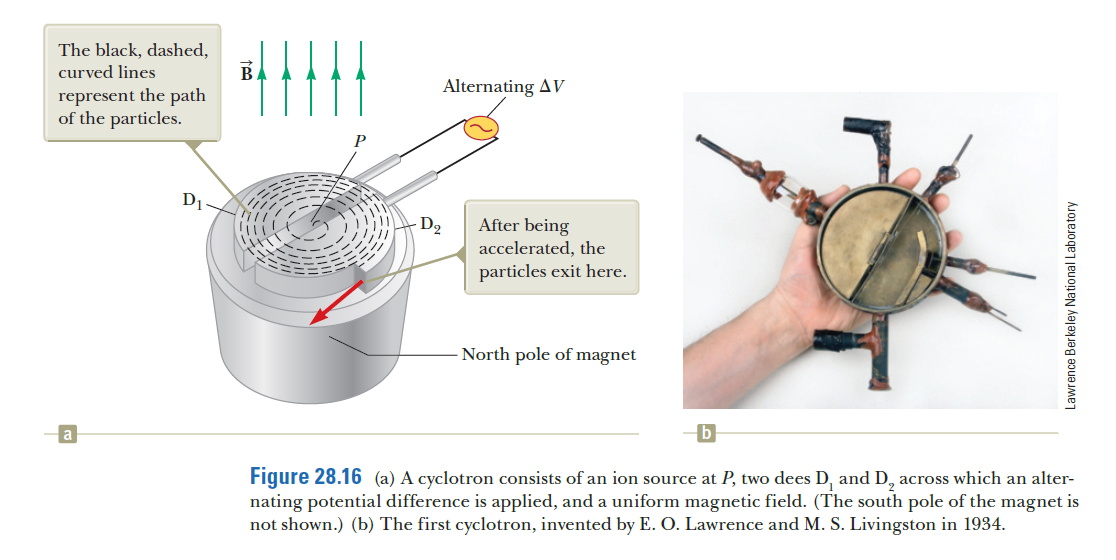The black, dashed, B represent the path of the particles. curved lines Alternating AV -D2 After being accelerated, the particles exit here. North pole of magnet a Figure 28.16 (a) A cyclotron consists of an ion source at P, two dees D, and D, across which an alter- nating potential difference is applied, and a uniform magnetic field. (The south pole of the magnet is not shown.) (b) The first cyclotron, invented by E. O. Lawrence and M. S. Livingston in 1934. Lawrence Berkeley National Laboratory
The black, dashed, B represent the path of the particles. curved lines Alternating AV -D2 After being accelerated, the particles exit here. North pole of magnet a Figure 28.16 (a) A cyclotron consists of an ion source at P, two dees D, and D, across which an alter- nating potential difference is applied, and a uniform magnetic field. (The south pole of the magnet is not shown.) (b) The first cyclotron, invented by E. O. Lawrence and M. S. Livingston in 1934. Lawrence Berkeley National Laboratory
Chapter12: Relativity, Particle Physics, And Cosmology
Section: Chapter Questions
Problem 33Q
Related questions
Question
A cyclotron (as shown) designed to accelerate protons has an outer radius of 0.350 m. The protons are emitted nearly at rest from a source at the center and are accelerated through 600 V each time they cross the gap between the dees. The dees are between the poles of an

Transcribed Image Text:The black, dashed,
B
represent the path
of the particles.
curved lines
Alternating AV
-D2
After being
accelerated, the
particles exit here.
North pole of magnet
a
Figure 28.16 (a) A cyclotron consists of an ion source at P, two dees D, and D, across which an alter-
nating potential difference is applied, and a uniform magnetic field. (The south pole of the magnet is
not shown.) (b) The first cyclotron, invented by E. O. Lawrence and M. S. Livingston in 1934.
Lawrence Berkeley National Laboratory
Expert Solution
This question has been solved!
Explore an expertly crafted, step-by-step solution for a thorough understanding of key concepts.
This is a popular solution!
Trending now
This is a popular solution!
Step by step
Solved in 4 steps with 3 images

Knowledge Booster
Learn more about
Need a deep-dive on the concept behind this application? Look no further. Learn more about this topic, physics and related others by exploring similar questions and additional content below.Recommended textbooks for you


College Physics
Physics
ISBN:
9781938168000
Author:
Paul Peter Urone, Roger Hinrichs
Publisher:
OpenStax College

Principles of Physics: A Calculus-Based Text
Physics
ISBN:
9781133104261
Author:
Raymond A. Serway, John W. Jewett
Publisher:
Cengage Learning


College Physics
Physics
ISBN:
9781938168000
Author:
Paul Peter Urone, Roger Hinrichs
Publisher:
OpenStax College

Principles of Physics: A Calculus-Based Text
Physics
ISBN:
9781133104261
Author:
Raymond A. Serway, John W. Jewett
Publisher:
Cengage Learning

Modern Physics
Physics
ISBN:
9781111794378
Author:
Raymond A. Serway, Clement J. Moses, Curt A. Moyer
Publisher:
Cengage Learning

Glencoe Physics: Principles and Problems, Student…
Physics
ISBN:
9780078807213
Author:
Paul W. Zitzewitz
Publisher:
Glencoe/McGraw-Hill